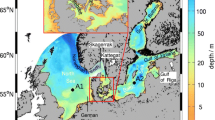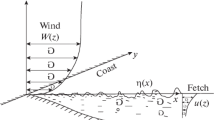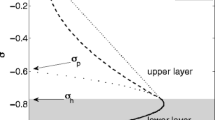Abstract
A two layer model of an infinitely long channel, with one end closed, is applied to study the sub-tidal response to wind forcing of Puget Sound. The model uses a linear friction parameterization. Data show that the acceleration of current near the surface responds to the wind event almost instantaneously, however, acceleration tends to start decreasing at later times and eventually changes sign even though the wind blows in one direction throughout. Analysis of the model results show that when the forcing frequency is high, the phase lag between forcing and friction causes this phenomena, and as forcing frequency increases, phase lag between forcing and friction approaches π/2. When the forcing frequency is low, phase lag between forcing and friction decreases almost linearly with forcing frequency and at extremely low frequency, they almost balance each other. Analysis of the model results show also that the amplitude of baroclinic pressure gradient increases rapidly as forcing frequency decreases and when the forcing frequency is low, the baroclinic pressure gradient becomes important. Effects of baroclinic pressure gradient propagate as a wave from the boundaries and it takes about one day to take effect at the point where the observations were made.
Similar content being viewed by others
References
Bretschneider, D. E., G. A. Cannon, J. R. Holbrook and D. J. Pashinski (1985): Variability of subtidal current structure in a fjord estuary: Puget Sound, Washington.J. Geophys. Res.,90, 11949–11958.
Buckley, J. R. and S. Pond (1976): Wind and the surface circulation of a fjord.J. Fish. Res. Board. Can.,33, 2265–2271.
Cannon, G. A. (1983): An overview of circulation in the Puget Sound estuarine system.NOAA Tech. Memo., ERL PMEL-48, 30 pp.
Cannon, G. A. and N. P. Laird (1978): Variability of current and water properties from year-long observations in a fjord estuary. p. 515–535. InHydrodynamics of Estuaries and Fjord, ed. by. J. C. J. Nihoul, Elsevier, Amsterdam.
Farmer, D. M. (1976): The influence of wind on the surface layer of a stratified inlet: Part II. Analysis.J. Phys. Oceanogr.,6, 941–952.
Farmer, D. M. and T. R. Osborn (1976): The influence of wind on the surface layer of a stratified inlet: Part I. Observations.J. Phys. Oceanogr.,6, 931–941.
Geyer, W. R. and G. A. Cannon (1982): Sill processes related to deep water renewal in a fjord.J. Geophys. Res.,87, 7985–7996.
Gill, A. E. (1982):Atmosphere-Ocean Dynamics. Academic Press, London, 662 pp.
Hansen, D. V. and M. Rattray, jr. (1965): Gravitational circulation in straits and estuaries.J. Mar. Res.,23, 104–122.
Matsuura, H. (1992): Wind effect on the sub-tidal current in Puget Sound. Ph.D. Disseration, University of Washington, 178 pp.
Svendsen, H. and R. O. R. Y. Thompson (1978): Wind-driven circulation in a fjord.J. Phys. Oceanogr.,8, 703–712.
Tee, K. T. (1989): Subtidal salinity and velocity variations in the St. Lawrence estuary.J. Geophys. Res.,94, 8075–8090.
Author information
Authors and Affiliations
Rights and permissions
About this article
Cite this article
Matsuura, H. An application of a two-layer model to wind driven sub-tidal currents in Puget Sound. J Oceanogr 51, 571–584 (1995). https://doi.org/10.1007/BF02270525
Received:
Revised:
Accepted:
Issue Date:
DOI: https://doi.org/10.1007/BF02270525




